

Vol. 40 (Number 28) Year 2019. Page 5
VIDISHCHEVA, Evgeniya V. 1; GUNARE, Marina 2 & MOLCHANOVA, Violetta S. 3
Received: 25/03/2019 • Approved: 04/08/2019 • Published 26/08/2019
ABSTRACT: In the modern world the creation of brand is an integral part of the development process at any levels (micro and macro environment). Branding is included in all spheres of the economy: from mechanical engineering to essential goods. The cultural brand is used as a popular tool of competition. The building of brand is included in the list of priority tasks of socio-economic development of the regions of the Russian Federation. Philip Kotler, founder of marketing science, said," If you're not a brand, you don't exist" (Kotler, 2010). The aim of the study is form a model of cultural brand development of Sochi city in modren conditions of internal and external environment. To achieve this goal, the following tasks were set and solved, to analyze and clarify the research base on topic under consideration; identify the unique features of cultural branding of Sochi city; make a list of proposed activities to include in the model; identify the factors affecting the pace and success of cultural territory branding. |
RESUMEN: En el mundo moderno, la creación de la marca es una parte integral del proceso de desarrollo en cualquier nivel (micro y macro ambiente). La marca está incluida en todas las esferas de la economía: desde la ingeniería mecánica hasta los bienes esenciales. La marca cultural se utiliza como una herramienta popular de competencia. La construcción de la marca está incluida en la lista de tareas prioritarias de desarrollo socioeconómico de las regiones de la Federación de Rusia. Philip Kotler, fundador de la ciencia del marketing, dijo: "Si no eres una marca, no existes" (Kotler, 2010). El objetivo del estudio es formar un modelo de desarrollo de marca cultural de la ciudad de Sochi en condiciones modernas de ambiente interno y externo. Para lograr este objetivo, se establecieron y resolvieron las siguientes tareas, para analizar y aclarar la base de investigación sobre el tema en consideración; identificar las características únicas de la marca cultural de la ciudad de Sochi; haga una lista de actividades propuestas para incluir en el modelo; Identificar los factores que afectan el ritmo y el éxito de la marca del territorio cultural. |
Branding of countries, regions, and cities is gradually becoming a mandatory part of the strategic development of territorial entities. The development and implementation of brand strategies has allowed many cities and countries to overcome the negative perception associated with the past of territories, and to reposition their brands. The cultural brand, as a unique category, includes the cultural and historical identity painted in national color, and representing the common value-heritage. Expansion and continuous development of the brand is extremely important for all regional entities, including those with a well-formed and quite successful brand. As for Sochi city, the creation of the cultural component of the brand should become an effective tool for territorial development, contributing to the competitiveness of the city, both at the national and international level. The study provides an analysis of existing approaches to the definition and modeling of branding processes, forms a model of cultural brand development on the example of Sochi city, and defines factors that determine the possibility of creation and development of the cultural territory brand.
The number of works of Russian and foreign scientists is dedicated to the study of the nature and characteristics of the "brand" concept (Filurin A.S., 2000; Kotler F., 2006; Chernatony L., 2007; Keller K., 2005; Sadriev R. D., 2007). In modern scientific and journalistic literature, the study of such type of brand as a cultural one is gaining popularity (Ni Czyaoczyo, 2015; Startseva A.S., 2014; Gritsenko V.P., 2016). The paper used materials from foreign and Russian periodicals, as well as available Internet resources. To achieve the goals, empirical and theoretical research methods were applied, such as collecting, studying and analyzing of data, compiling and comparing, as well as methods of system and factor analysis.
In the scientific literature there are many different definitions of the brand concept and essence. In the most complete way brand can be described as a set of ideas about the product, service or territory, which forms a holistic image and determines one's differences from competitors in the perception of potential consumers. The brand forms the unique properties of a product or service in the minds of consumers through symbolism and communication. From an economic point of view, territory brand is a demonstration and guarantor of its competitive advantages (Anholt, 2005). In this study such a variety of brand as cultural is under the most interest. This form of brand is based on the historical and cultural resources of the region, such as traditions, scientific and technological achievements, works of art, architecture, etc. (Startseva, 2014). It is worth noting the importance of global recognition of the brand value. In other words, to become a brand, the historical and cultural component of the territory must not only be relevant to the history and culture of the region, but also be the cultural heritage of the country.
The cultural brand of the municipality is a kind of territorial brand. Branding of territories (places) has a number of features that should be taken into account when forming branding models. Often, the brand of the territory is used as a tool for the implementation of the regional development strategy. The works of many scientists are devoted to the study of the territory brand, so there are so many different definitions of the term in the scientific literature. After analyzing the most interesting and accurate concepts we can highlight the main elements of the territory brand, which are reflected in all interpretations. Figure 1 presents several concepts of the brand territory and the identified key components of the brand.
Figure 1
Author's interpretations of the "brand of the territory"
concept and its key components
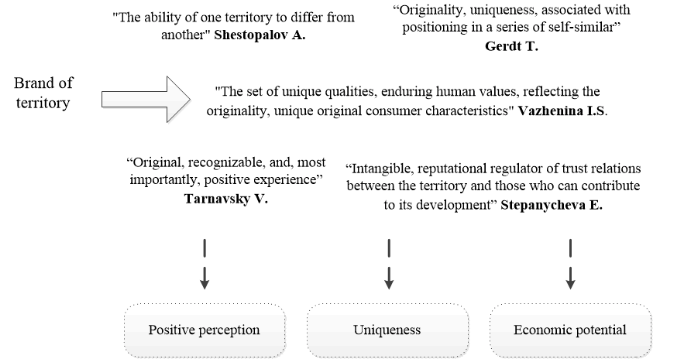
Compiled by the authors on the basis: Gerdt, 2007; Tarnavsky, 2011;
Shestopalov, 2006; Stepanycheva, 2012; Vazhenina, 2010
The main components of the territorial brand are clearly distinguished from the set of author's interpretations: positive perception by the consumer sector, the presence of uniqueness, the potential for profit and other socio-economic benefits.
After analysis of presented definitions, we can form a complete definition of the territory brand. In this way, the brand of the territory is a positive image in the impression of potential consumers, highlighting the territory among analogues, as well as the sum of all the unique characteristics of the area that determine its competitive identity and potential profitability. It’s worth noting that, when defining a brand on the scale of a territorial entity, it is impossible to bypass the economic component. Since the brand mainly works for the economy of the region, attracting cash flows, investments, business and personnel, at the same time contributing to the solution of social issues.
A distinctive feature of the territorial brand is its social orientation, which means the desire to increase the welfare of local consumers and the whole territorial community.
According to opinions of some foreign scientists, any brand of the territory has a cultural value. The cultural component is presented in some definitions of the term "territory brand". For example, Ishus, Jasper and others define the brand of the place (territory) as a symbolic structure designed to increase the importance and value of the place, and causing associations that fill the place with cultural significance (Eshuis & others, 2014).
The analysis of research base of cultural brand as a kind of territorial brand allows us to distinguish the following features of this concept:
• The brand is based on the cultural and historical heritage, which forms the identity and attractiveness of the territory.
• The process of brand creation requires support of governmental structures.
• Contributes to the development of cultural and historical awareness and literacy of the local population.
• Forms the external image of the territory and the country as a whole, by increasing the contribution of the territory to world culture.
• The cognitive component of a cultural brand does not depend on the time flow or fashion: the city in which the Olympic games were held, or the residence of the Royal family will forever remain so in the perception of citizens.
The interest to the study of the essence of cultural territory brand increases every year, new approaches are formed. However, today there is no common understanding – the definition of this phenomenon. Ni Czyaoczyao defines a cultural brand as a phenomenon of creating an image with the involvement of cultural (historical, religious, musical, artistic and other) resources (Czyaoczyao, 2016). Startseva A.S. sees a unique common value at the heart of the cultural brand: "a set of functional and emotional values that offers consumers a unique and positive experience" (Startseva, 2014). Gritsenko V.P. describes the role of common cultural values and their development in the process of cultural brand building. He underlines that cultural brand of the territory can function effectively "only within the framework of society with a cultural paradigm" (Gritsenko, 2016).
Modern understanding of cultural heritage includes not only cultural and historical monuments, but also the environment, natural landscapes, engineering structures, moral and aesthetic ideals, norms of behavior, dialects, traditions, customs, folklore, arts and crafts (The Concept, 2013). On the basis of the cultural heritage of the territory, the population can build effective social strategies, expand the market for cultural services and products, develop tourism and the cultural sphere. Since the successful use of cultural potential depends on effective management, it is of particular importance to develop strategies, approaches and models to preserve and develop this wealth and pass it on to future generations.
The use of modeling for description of processes or phenomena is actively used in the modern scientific community. The model in this case is a complex system that reflects the interaction of all involved subjects throughout all stages of the existence of a phenomenon or process.
Now we consider the theoretical approaches to the territory brands modeling. One of the first theoretical models of the territory brand is considered to be the hexagon of Anholt S. (2010), which determines the competitive identity of the national brand. According to this model, six elements of the competitive environment equally form the brand of the territory (figure 2).
Figure 2
Model of the territory brand by Anholt S.
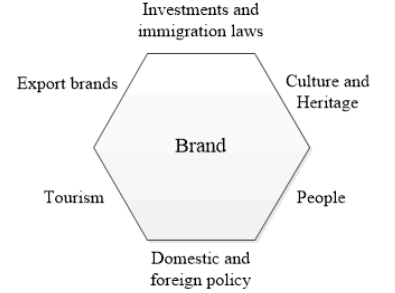
(Anholt, 2005)
To our opinion, this model is not a full-fledged model of the territorial brand, as it lacks the structural relationship between the elements, as well as the involvement of a subjects or elements within a specific stage of the formation and life of the brand. This way - describing the brand as an interaction of several elements - is used by many scientists for modeling (Stepanycheva E.V., Kavaratzis M. and others). This approach can be described as structural.
Hankinson's model (Hankinson, 2004) belongs to another group of models – communicational or network, as it describes the relationships and connections of elements within a particular brand. In the specialized literature can be also found the term "wheel model" that can be applied to models of Hankinson G., Cai L. (Cai, 2002), Chernatony L. (Chernatony, 2007) and other researchers. A distinctive feature of these models is the presence of the core – the essence of the brand around which the elements of the brand interact.
Most often the development of the territorial brand is associated with the tourism and recreational sector, as all aspects of the marketing of places are implemented in tourism. Tourism acts as a catalyst and accumulator of cultural and symbolic values, presenting its to the outside world. In this regard, there are a number of scientific papers covering the promotion, marketing and branding of tourist areas.
The third group includes models of process type, which describe the process of brand formation. These are the model of local brand building of Gadgiotti H., a model of strategic territorial brand management of Hanna S. and Rowley J. and other. The algorithm of brand construction of Gadgiotti H. is in turning resources into capacities through the implementation of assessments of the prospects and positioning of the territory identity (Gadgiotti & others, 2008).
The model of Hannah S. and Rowley J. is considered to be the most practical, since it was tested by expert evaluation (figure 3).
Figure 3
The model of the territorial brand
management Hanna S. and Rowley J.
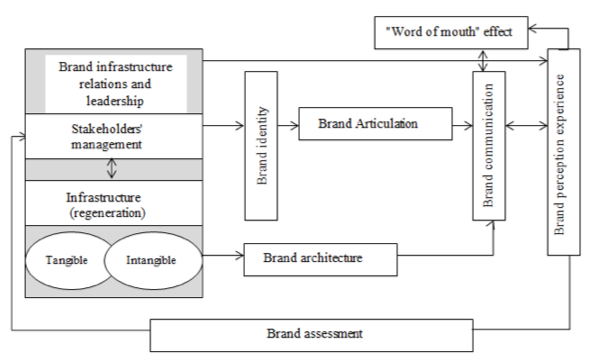
(Hanna & Rowley, 2011)
All developed models are unified and describe the brand and the process of its creation without taking into account the specifics (type) of the brand. Today in the literature there is no full-fledged model of building and development of cultural brand of the territory. At the same time, there are cultural aspects in the models of Hannah S. and Rowley J. and other.
In theory the formation of a cultural brand can be adjusted to any of the presented models. But in order to consider the studied process in details, it is necessary to make a comprehensive model of the process of promoting the cultural brand. We suggest the following model, shown in figure 4.
Figure 4
Model of formation of cultural
territory (city) brand
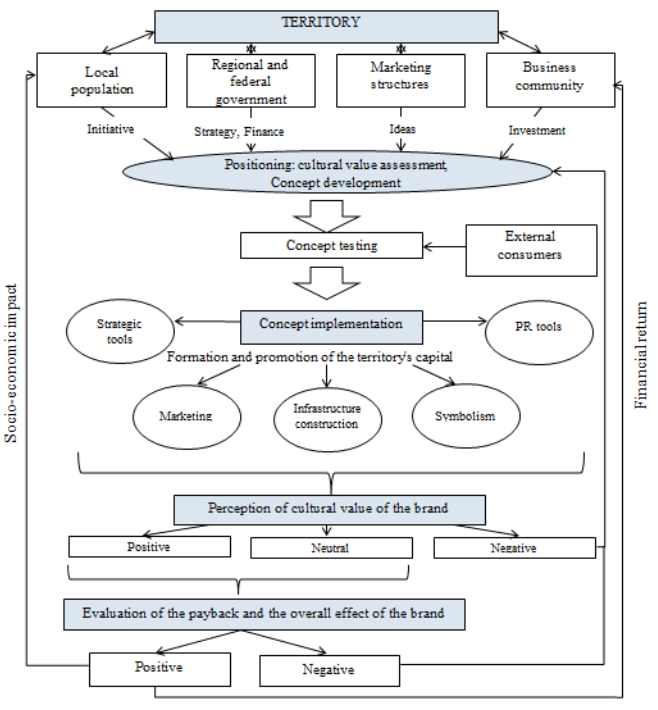
(compiled by the authors)
The subjects in this model are so-called stakeholders: local population, business community, investors, regional authorities, government, and external consumers. They are the initiators and engines of the process of creation and promotion of the territorial brand, as well as the final recipients of socio-economic benefits and advantages. Scheme below shows that negative perception of a formed brand leads to the need to re-evaluate territorial values and develop a new concept. This process is rather expensive, requires time and efforts. Considering long-term period of brand adjustment and promoting, it is unacceptable to make mistakes at the stage of the formation of conceptual approach to a particular brand product.
While developing a model for a particular territorial entity, it is necessary to take into account its unique features, strengths and weaknesses. Today the cultural component of Sochi brand is limited to the heritage of one-time and repeating events. As mentioned above, the cultural brand is a set of cultural and historical values of the territory, which form a unique image in the perception of consumers. The elements of positioning of the Sochi city include: Post-Olympic heritage, Black sea, balneological resort Matsesta and Sochi National Park. Among the objects of cultural and historical value, are widely known and offered to tourists-limited number: dolmens, caves, temples.
The lack of cultural component in the city brand is a serious risk and the main problem of the municipality image, potentially able to undermine the stability of the region 's popularity. It’s worth reminding that more than 70% of the world's tourism is cultural destinations, tourist flows are attracted by cultural and historical heritage, monuments, museums, rich cultural life. The objects of cultural and historical value capable to attract interest of a wide audience, can extend the average stay time of tourists at the resort, as addition to other types of tourism, such as beach, medical, congress and others. The correct branding program of the city creates the following positive effect: it is a source of pride for the local population and the urge to recommend this area to visit.
With a variety of modern methods of brand promotion, there is no single win-win option; each area requires a special approach. To form a model of cultural branding of the city of Sochi, we firstly need to consider the potential and peculiarities of the region. Sochi uses more aggressive brand promotion tactics and is rapidly becoming a world-class resort. Such tactics require serious financial investments, support of the authorities and the use of big events (event marketing) to attract the attention of the world community. Olympic Games were important event for Sochi city, they say Sochi "woke up" famous after the Games. However, to become a platform for a large-scale event is not enough to form a cultural brand of the resort city.
There are many examples of irrational post-Olympic management, which leads to the non-use of the Olympic heritage and the fall of city popularity. Sochi, with successfully formed brand, continues its support, which stimulates the growth of tourist flows after the Olympic games. However, relying solely on the event heritage is unacceptable, and Sochi needs to reinforce the interest of consumers through the formation and promotion of eternal cultural and historical values. The revival of cultural and historical identity of the Sochi city is a complex multi-stage process that requires long-term planning, consolidation of efforts of local and regional authorities, as well as public-private partnership. The basis of this process is the formation of a cultural product and the expansion of the cultural life of the resort city. That is, to improve the image of the city as a cultural center, it is necessary, first of all, to reveal the cultural potential of the territory.
The cultural component of the Sochi identity has not been given due attention for many years. It is caused by the presence of other major factors that attract tourists and investment flows to the region. However, it is widely known that culture is a source of harmonious society development, and it attracts sustainably increasing interest in recent years. In this regard, today territories need to actively develop their cultural identity to improve the image and to increase its attractiveness in the eyes of potential consumers.
In accordance with the existing tools of territory branding, we suggest to highlight the following groups of activities aimed at the development of the cultural brand of the Sochi city.
1. Institutional events - formation of a specialized unit with full responsibility for the implementation of brand events and brand development, and stimulation of activity of the Department of culture of the Sochi city, etc;
2. Strategic activities, which are based on the formation of the brand product, namely the restoration and maintenance of the cultural identity of the city by expanding the existing programs and strategic documents and improving the quality of control over their implementation. The effectiveness of strategic planning is proved by examples of many cities and regions. Clearly formulated plan of activities and target indicators significantly reduce material and time costs;
3. Infrastructure activities - creation of platforms to attract major events of art sphere, increase of availability of existing facilities, including the removal of social barriers aimed to attract the attention of young people to the Museum and exhibition complexes. The expansion of the cultural infrastructure will favorably affect the livelihoods of the local population, providing a variety of forms of leisure activities, increasing the level of cultural awareness and education, which together will have a beneficial effect on the image of the city as a place to live;
4. Marketing activities - promotion of the territory image, in particular the symbolic forms of the brand, through advertising, media, congress and exhibition activities and other forms. The efficiency of such events is confirmed by the experience of the previous marketing policy during the preparation of the Olympic and Paralympic Games of 2014;
5. Events for the formation of a visual image - a symbolic form of the region: expansion of the image of Sochi-2014 in the public perception. The brand “Sochi-2014” is very successful, so the most optimal way to supplement the existing image with a cultural product is internal development and active positioning of cultural identity in close connection with well- known image.
The program of recommended activities to improve the image of the Sochi city has to be diverse, complex and be designed mostly for long-term implementation. We provide the following step-by-step model for the implementation of the program for the development of the cultural brand of Sochi (figure 5).
Figure 5
A staged model of Sochi cultural branding
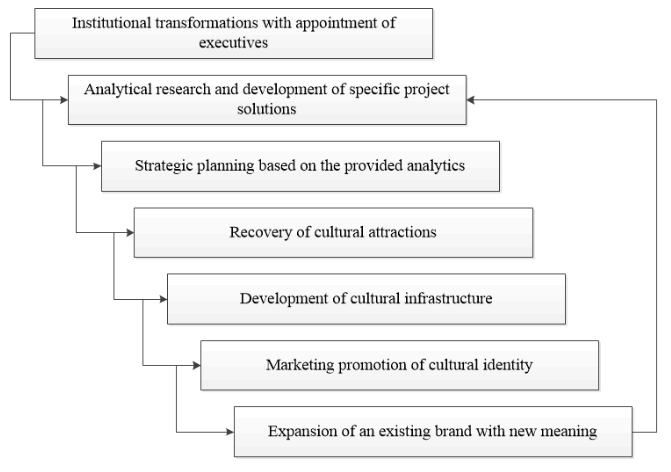
(compiled by the author)
Taking into account the interests of all stakeholders plays an important role in the implementation of the image policy of the resort region. Accountability and consistency of all processes, as well as an effective control system will allow to avoid conflict situations and accelerate the process. That is why it is necessary to develop and implement an effective mechanism of cultural branding of the Olympic city.
The participants of promotion brand activities of the region: Department of culture of the city, municipal authorities, departments of infrastructure, construction and culture, specialized institutions, cultural and art institutions, authorized marketing agencies, investors, the public, as well as the consumer (word of mouth). All listed branding participants should perform their functions at a certain stage of the brand promotion process. The organizational model of positioning of the cultural brand of Sochi is shown in figure 6.
The supreme body coordinating the implementation of program activities is Department of Culture of Sochi city. The Department directly approves program documents and road maps, organizes a search for finances, and monitors the implementation process and the final result of branding activities.
Figure 6
Organizational model of Sochi cultural branding
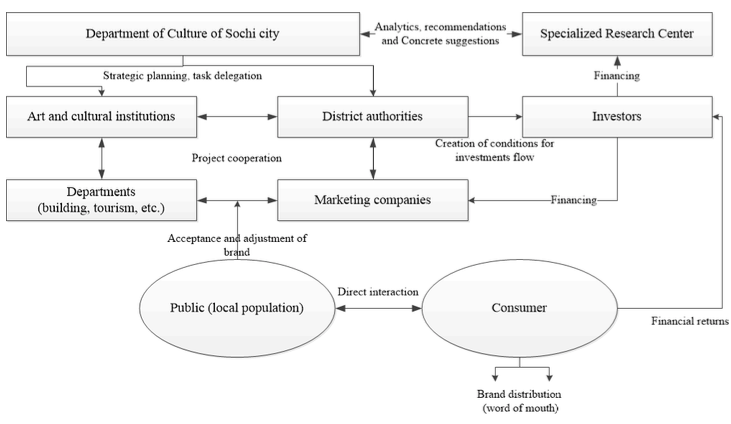
(compiled by the author)
The creation of unique territorial brand, as well as the potential for its further development is due to the influence of many factors. Traditionally, factors are divided into external and internal. Depending on the stage of the process, branding activities face various obstacles and incentives. Based on the key stages presented in figure 5, first of all, we consider the factors affecting the reliability of the territorial potential assessment. Among the constraints at this stage, we highlight:
• Inaccurate or incomplete statistical reports;
• Interest of stakeholders: attempts to mislead;
• Human factor: errors, inaccuracies;
• Rapidly changing situation;
• Low level of interaction between municipal and regional authorities.
Governmental support, a high level of trust between the Federal and local authorities, the availability of relevant data on the characteristics of the region, as well as the involvement of the local population in the assessment through surveys, on the contrary, can contribute to rapid and, most importantly, adequate assessment.
Detailed assessment of identified potential factors is presented in table 1.
Table 1
Factors of formation and development
of cultural territory brand
|
Stimulating |
Deterrent |
Internal |
The possibility of holding large-scale events in the region; Reasonable use of cultural and historical heritage; Geographical location of the territory; Transport accessibility; Political stability in the region; Tourism development, high attendance of the territory; High education level of the local population |
Geographical location of the territory; Transport accessibility; Competition with other destinations; Low level of education or cultural literacy of local population; Low level of IT-technologies development; The unstable economic situation in the country; Unattractiveness of the brand in the eyes of potential consumers; Lack of financing |
External |
Growth of national and world tourism; Interest to the country and region; Budget support; High level of cultural development in the country; Integration of the country into the world economic and political space; High informatization level of society |
The economic situation in the world; Negative image of the country in the eyes of the world community; Political confrontations with other countries; Low income of the country's population; Cultural and ethical differences |
Source: compiled by the author
Based on the data of the table, we will make a classification of the factors that determine the ability of the territory to adopt the brand (figure 7).
Figure 7
Factors of formation and development
of cultural territory brand
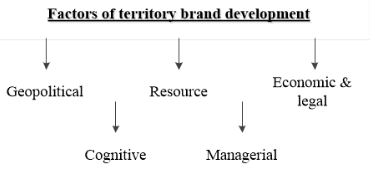
(compiled by the author)
Geopolitical factors include the foreign policy environment, geographical location, and all other aspects of the territory perception, both by local consumers and at distance ones. The resource group includes all obstacles and incentives related to the identity of the territory. Economic and legal factors determine the development of any process associated with human activity. In relation to the brand, they are understood as a set of legal norms, the relationship between the levels of authorities, competition and so on. Cognitive factors include the ability of a potential consumer to assess the cultural identity and value of the brand: level of education, cultural and ethical aspects of perception or development of culture in the region. Management factors play an important role in the formation and promotion of the brand. Untimely or illiterate management decisions can become a serious threat for realization of even the most unique and ambitious potential.
The variety of factors that have a direct or indirect impact on the process of formation and further development of the territory brand indicates the complexity of this process and confirms the need for its detailed study.
In order to increase the effectiveness of branding activities under the influence of such amount of factors, it is necessary to develop an effective mechanism for monitoring and interaction with the responsible executors. This mechanism may involve independent observers, for example local population. The proposed mechanism for step-by-step monitoring of the implementation of branding police is presented in figure 8.
Figure 8
Mechanism for control of
branding activities realizatio
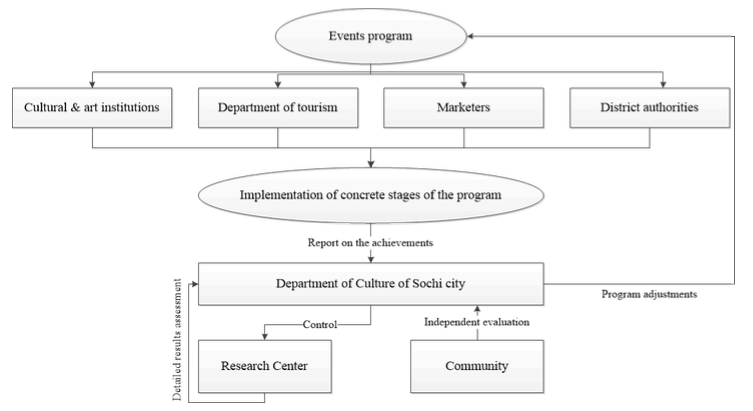
(compiled by the author)
In general, the promotion of the cultural brand of the Sochi city should be a complex process of internal and external communications between the responsible executers, regulatory authorities and the audience, aimed at the most rapid and least costly achievement of the goal. The development of culture and the formation of a new image of the city will provide both economic growth, and increase the overall image of the region as a place for living and personal development.
As a result of the study the following aims were achieved:
- The analysis of the existing research framework of the concepts of the territory brand and cultural branding;
- Identification of key components and features of the territorial brand, and formation of its full definition;
- Consideration of existing theoretical models for place branding, and development of the author's model of cultural branding;
- Formation of step-by-step and organizational models of Sochi cultural branding, proposal of a system for monitoring the implementation of activities within the framework of the created model;
- Identification of factors influencing the formation and development of the territory’s cultural brand.
The lack of cultural component in the city brand is a serious risk and the main problem of the municipality image, which is potentially able to undermine the stability of the region's popularity. The objects of cultural and historical value capable to attract interest of a wide audience, can extend the average stay time of tourists at the resort, as addition to other types of tourism, such as beach, medical, congress and others.
The effectiveness of the proposed model is due to such factors as the widespread growth of the popularity of the cultural sphere in the modern world; the presence of a well-known and, importantly, a successful brand "Sochi-2014", which allows to significantly reduce the efforts for promotion of the cultural product of the brand, as well as the rich cultural and historical heritage of the city.
The Sochi city needs to reinforce the interest of consumers through the formation and promotion of eternal cultural and historical values. The revival of cultural and historical identity of the Sochi city is a complex multi-stage process that requires long-term planning, consolidation of efforts of local and regional authorities, as well as public-private partnership. The basis of this process is the formation of a cultural product and the expansion of the cultural life of the resort city.
Anholt S. (2005). Brand New Justice: How Branding Places and Products Can Help the Developing World. [Electronic resource]. URL: www. books.google.ru
Cai L. (2002) Cooperative branding for rural destinations // Annals of Tourism Research, Vol. 29, No. 3, pp. 720-742
Chernatony L. (2007). From brand vision to brand evaluation. The strategic process of growing and strengthening brands // L. Chernatony; Translation from English. M.: The ETC group, 332 p.
Czyaoczyao Ni (2016). Cultural brands of China as a resource for regional development (on the example of Hebei province) // Russia and China: problems of strategic interaction: Collection of the Eastern Center, No.18, pp. 13-20 [Electronic resource]. URL: https://elibrary.ru/item.asp?id=28380942
Eshuis, Jasper, Klijn, Erik-Hans, & Braun, Erik (2014). Place marketing and citizen participation: branding as strategy to address the emotional dimension of policy making? // International Review of Administrative sciences, Vol. 80(1), pp. 151-171. [Electronic resource]. URL: https://www.researchgate.net
Filyurin A.S. (2000). Patency is practically a medical term for almost clinical cases. Russian regional features of branding / / Marketing and marketing research in Russia, No. 5, pp. 56-59
Gadgiotti H., Low K., Patrick C.& Yunak O. (2008). City Brand Management (CBM): The Case of Kazahstan // Place Branding and Public Diplomacy, Vol. 4, pp. 115-123
Gritsenko V. P. (2016). Branding in the context of new strategies of cultural development of the Russian Federation // Bulletin of the Krasnodar state Institute of culture No. 2(6), pp. 25-29. [Electronic resource]. URL: https://elibrary.ru/item.asp?id=26415116
Hankinson G. (2004). Relational network brands: Towards a conceptual model of place brands // Journal of Vacation Marketing, Vol. 10, pp. 109-121 [Electronic resource]. URL: http://journals.sagepub.com/doi/10.1177/135676670401000202
Hanna S. & Rowley J. (2011) Towards a Strategic place brand management model // Journal of Marketing Management, Vol. 27, No. 5/6, pp. 458-476
Kavaratzis M. (2004). From city marketing to city branding: Towards a theoretical framework for developing city brands // Place Branding, No. 1(1), pp. 58-73 [Electronic resource]. URL: https://www.researchgate.net/publication/32006174_From_City_Marketing_to_City_Branding_Towards_a_Theoretical_Framework_for_Developing_City_Brands
Keller K.L. (2005). Strategic brand management: creation, evaluation and management of branded capital // K.L. Keller. - M.: Williams, 704 p.
Kotler F. (2010). Marketing from A to Ya: 80 concepts that every Manager should know // Philip Kotler; Translation from English. - M.: Alpina Publishers, 211 p.
Kotler F. (2006). Marketing of the XXI century // F. Kotler; Translation from English, ed. T.R. Theor. – SPb.: Publishing House "Neva", 224 p.
Sadriev R.D. (2007). On the concept of "brand" and the role of the brand in the company // Marketing in Russia and abroad. No.1 [Electronic resource]. URL: http://dis.ru/library/541/26358
Startseva A.S. (2014). Phenomenon of cultural brand in the process of creating the image of Russian regions // Bulletin of the Moscow state University of Culture and Arts No. 4(60), pp. 195-200 [Electronic resource]. URL: https://elibrary.ru/item.asp?id=22132986&
Stepanycheva E.V. (2012). Conceptual approach to the formation of the territory brand // Socio-economic phenomena and processes, No. 12(046), pp. 288-295 [Electronic resource]. URL: https://elibrary.ru/item.asp?id=19001268
The Concept (2013). The concept of sustainable development of Sochi city until 2030 // Moscow. [Electronic resource]. URL: http://pdf.knigi-x.ru/21ekonomika/95913-1-koncepciya-ustoychivogo-razvitiya-goroda-sochi-2030-goda-uchetom-ispolzovaniya-sorevno.php
1. Sochi State University, Russian Federation. E-mail: evgenia-vv@mail.ru
2. Baltic International Academy, Latvia. E-mail: marina.gunare@gmail.com
3. International Network Center for Fundamental and Applied Research, Washington, USA. Volgograd State University, Russian Federation. Corresponding author. E-mail: v.molchanova_1991@list.ru